Jan. 4, 2016 About a year after I wrote this initial post, Lottie dolls have reached the stars, with recent accolades as the first doll in space designed as Stargazer Lottie by a six year old Canadian child. On Dec. 15, 2015, she launched into the media with input from real life ‘sheroes’ like astronomer Karen Masters and a hand from our own filmmaker friend Elena Rossini of The Illusionists who created this video short of Abigail inspiring STEM girls worldwide. She called it her “coolest assignment to date” filming about the first doll to reach the International Space Station. Here’s more from the Lottie Dolls blog with goosebump inducing quotes from this eloquent child. One one of my favorites is shown with Abigail herself pictured below from their site…
Dec. 14, 2015 Update Adding some holiday cheer and GOOD news for 2015, just look at all these companies joining in the effort to create healthier worldviews for girls, from I Am Elemental to Let Toys Be Toys and their victory in the UK with ToysRUs to upend damaging gender stereotypes and limited mindsets in the toy aisle! 2015 shows we’ve ‘come a long way’ with calling out misguided media and marketing missteps, so cheers to 2016 innovation raising the bar even further, for ‘tidings of comfort and joy’…
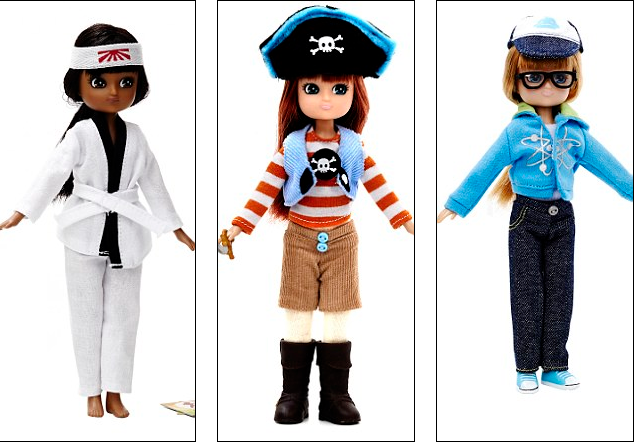 Dec. 15, 2014 Wishes apparently do come true, as parents who hoped for a ‘market correction’ in the toy aisle to “let kids be kids” are finally able to find healthier, age appropriate indie offerings veering AWAY from the hypersexualized sameness of mass produced glop!
Dec. 15, 2014 Wishes apparently do come true, as parents who hoped for a ‘market correction’ in the toy aisle to “let kids be kids” are finally able to find healthier, age appropriate indie offerings veering AWAY from the hypersexualized sameness of mass produced glop!
Heads up mega corps and retailers, THESE are the “ones to watch” at trend tracking industry happenings like the upcoming giant Toy Fair 2015.
Lottie Dolls from Arklu in the UK and GoGoSports Girls from Dream Big in the USA are two of the award-winning brands created by passionistas who staked their careers (and personal assets!) to self-fund companies with positive messages and behavioral cues to kids that parents can proudly embrace without squirming. Both offer unstructured, imaginative play, both are expanding into read along story books, and both have received the prestigious Oppenheimer Platinum Award.
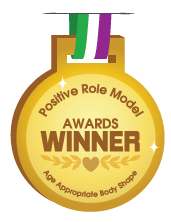 From sturdier body image constructs, to diversity and representation of interests beyond fluff-n-stuff, these dolls take a “see it, be it” pathway reflecting REAL kids instead of the ludicrous ‘aspirational’ push towards puberty with breast bumps at increasingly earlier ages. (Even beloved Lego fell prey to this breast/chest curvy nonsense with their “Friends” line instead of building on brain plasticity to seed positive pathways and correct the wrong-headed steerage toward overly gendered toys)
From sturdier body image constructs, to diversity and representation of interests beyond fluff-n-stuff, these dolls take a “see it, be it” pathway reflecting REAL kids instead of the ludicrous ‘aspirational’ push towards puberty with breast bumps at increasingly earlier ages. (Even beloved Lego fell prey to this breast/chest curvy nonsense with their “Friends” line instead of building on brain plasticity to seed positive pathways and correct the wrong-headed steerage toward overly gendered toys)
It’s exciting to see both of these small companies actively reversing the damage of clueless marketing capers that have gender stratified and subliminally upended the confidence of even very young girls by focusing on appearance over substance.
Today’s interview focus is Arklu’s Lottie Doll, a toy that at its essence is a fun, fashion doll with eight differentiating factors they handily spelled out, which frankly really DO set the toy apart in healthy, imaginative play. Rather than try to cram all STEM specifics into a superhero marketing mix, Lottie Dolls allude to the play patterns of a 9-year old girl, building in seamless assumptions of leadership in a wide array of dolls, as if to say…
“Of course girls can do this, why wouldn’t they?”
And boys? Again, their stance is that of course they play with girls, sharing vignettes and storytelling and action and drama, co-playing with each other like many siblings have for years.
It’s like a presumptive shoulder shrug to ‘get back to where we once belonged’ while being acutely aware through market research how dangerously far we’ve fouled up the works with cues to kids through productization, appearance-obsessions, and gender-stratification.
Encore! Wild applause! “Hashtag: #MoreLikeThisPlease?”
Media is finally catching up with the notion that the messages being put out there are packing a wallop, and it’s not pretty. Invisible shields of “just don’t buy it” are harder to deploy when the sheer volume of messages that sexualize childhood dominate retail shelves and air waves. If you think “it’s gotten worse”…it clearly has. The fact that toys are more gendered and sexist than they were 50 years ago is beyond disturbing, as articulate researchers like Elizabeth Sweet cite in The Atlantic noting this tenor also smacks up against the big push towards “making STEM more inviting for girls.”
This post, “How toys tell girls STEM is not for them” adeptly cites specifics in a searing, change-worthy indictment of our current cultural state. Toss in the daily doings of everyday workplace environments that challenge women already IN STEM fields and we have a mess of a mop up that goes far beyond the toy aisles.
So what can we do to right these wrongs? Consumers can put pressures on manufacturers to knock it off, and champion change with our wallets to make choices that reflect healthier worldviews and “positive picks.” Thankfully, it feels like the toy tide may finally be changing and 2015 may be the year of a colossal tsunami toward healthier pursuits.
David and Goliath: Fighting Stereotypes in the Toy Aisle
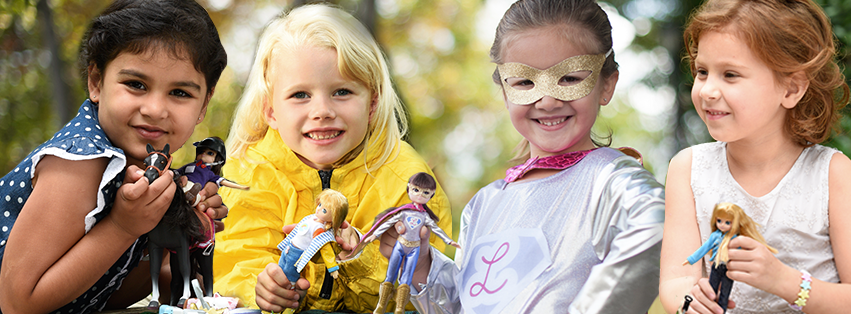 When Lottie Dolls first launched, this Guardian article notes “Arklu did a survey in which parents talked of their concerns about very young girls not wanting to wear certain clothes because they would look fat. ‘My daughter told me she had fat legs and tummy and needed to make them smaller – she was four at the time!’ said one. “Moore admits this is one of Lottie’s big selling points. ‘I love her chunky thighs. I’ve got them too and have always hated them. In fact, I should love them and point out how good they are for running and being strong.’ My own daughters also liked Lottie. ‘I like her leggings, they’re just like mine,’ said the five-year-old.
When Lottie Dolls first launched, this Guardian article notes “Arklu did a survey in which parents talked of their concerns about very young girls not wanting to wear certain clothes because they would look fat. ‘My daughter told me she had fat legs and tummy and needed to make them smaller – she was four at the time!’ said one. “Moore admits this is one of Lottie’s big selling points. ‘I love her chunky thighs. I’ve got them too and have always hated them. In fact, I should love them and point out how good they are for running and being strong.’ My own daughters also liked Lottie. ‘I like her leggings, they’re just like mine,’ said the five-year-old.
Our own body image advisory board member and fellow Brave Girls Alliance partner, Dr. Robyn Silverman echoed the dire developmental angst at the preK stage in this post about ‘fat talking tots’ as young as age three. Time for a cool change, indeed.
 In an era where public health is thrown under the bus for profit, and out of control body image distortions are landing on wee ones, we need some “David and Goliath” representation in the store aisle to right some wrongs.
In an era where public health is thrown under the bus for profit, and out of control body image distortions are landing on wee ones, we need some “David and Goliath” representation in the store aisle to right some wrongs.
When it’s necessary for a bipartisan body image bill addressing children’s health, carrying Congressional updates into 2015 to correct some very real damage to kids physical and socio-emotional wellness via unattainable Photoshop ideals, it’s a “Houston we’ve got a problem” element that sadly hasn’t been tracked by industry with any sense of ethical obligation.
As I’ve said so many times, we’ve seen cash registers go ka-ching and kids psyches go ka-boom profiting off of insecurities sold to kids far too young to have the critical thinking to discern otherwise. Lottie Dolls offers a subtle, pre-emptive, proactive alternative by creating a simple doll line that bumps up against vapid values to create more uplifting, positive choices.
Gazing Into a World of Possibilities in 2015
In today’s pop culture zeitgeist where “stargazing” often alludes to celebrity fixations, Lottie dolls is already trumping the toy aisle to open the eyes and imaginations of kids universally with their upcoming “Stargazer Lottie” an exciting partnership in collaboration with the European Space Agency (ESA) in 2015.
They’re also launching a new “Fossil Hunter Lottie doll” to unearth the contributions of women in archaeology, paleontology and geology via an alliance with the aptly named “Trowel Blazers” international team of scientists.
I love this; the power of media to position adventure and discovery in fun fresh ways it reminds me of how fast pop culture can amplify and flip the message toward positive pursuits.
Think about how fast the popularity of “Night at the Museum” turned into a ‘night of history lessons’ drawing attention to artifacts of the past with coolness cache…Or, or how Hoot or Ice Age sent eco messages, or even how characters like Ross on the TV show Friends brought paleontology into the lexicon of a whole generation.
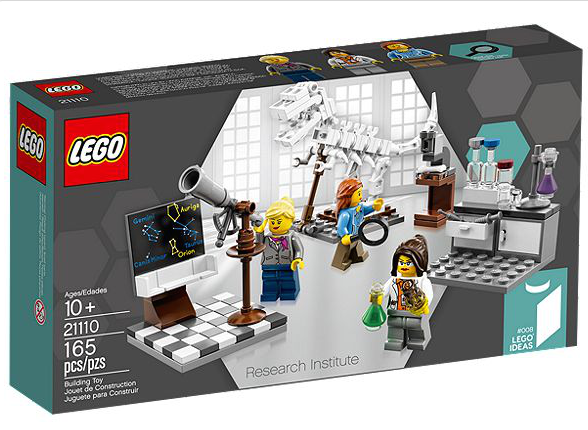 Using media and marketing in positive ways is like a ‘show and tell’ primer of persuasion, suggesting what’s possible…much like the Lego female scientist mini-figures that were voted into being via the Lego Ideas panel, sold out in a flash, and were reintroduced on a limited basis this week only to sell out AGAIN online today.
Using media and marketing in positive ways is like a ‘show and tell’ primer of persuasion, suggesting what’s possible…much like the Lego female scientist mini-figures that were voted into being via the Lego Ideas panel, sold out in a flash, and were reintroduced on a limited basis this week only to sell out AGAIN online today.
Why are big box retailers hawking scads of “Lego Friends” when female scientists are selling like hotcakes?
Why do we accept being stuck in the muck of appearance-based ‘hottie’ cues when large brands could make money selling wider swaths of interests and career paths?
Even big brands have proved ditching stereotypes for healthier portrayals can lead to profitability along with positive change. Look at the massive success of Doc McStuffins and Dora the Explorer which will hopefully leave the Bratz beauty bilge and Monster High ghouls languishing on retail shelves as ‘has beens’ past their expiration date. (dare to dream…)
Parents want it. Kids deserve it.
When all ages are desperately seeking an escape from a tipping point of toxicity, Lottie Dolls and healthier offerings like it are ripe to capture some of this momentum. For those like me who have railed against ‘dumbed down’ dolls and wince-worthy mass market offerings that I can’t even buy to donate to Toys for Tots, it’s great to see a quality, affordable doll gain traction, with 2015 marking expansion into some amazing partnerships for the line.
Lucie Follett, Co-Founder and Creative Director:
“We wanted to create something really inspiring, upbeat, fun and positive, targeted towards children, but also demonstrate in a light-hearted manner how we’re working to ‘bury’ the toxic beauty standards that pervade society and have such negative implications for girls. We want girls to see the full range of possibilities open to them, and girls being supportive of one another in their interests and activities, however diverse those choices might be. Every girl is unique and that uniqueness should be celebrated.”
Mind you, with all the ‘girl empowerment/supershero’ advertising which is wildly popular right now, I think we’re going to see some fatigue factor with the STEM/fem push towards “sheroes” at every turn as we make sustainable advancements in “Redefining Girly.”
I’m sure there will also be some “what about the boys” queries from parents with sons too…but Lottie Dolls already passes that ‘sniff test’ far exceeding any bandwagoning or STEM/fem trends du jour. Their over-arching points of differentiation strike me in a much larger context of child development and pretend play.
For starters, they’re ahead of the game, asking important questions…Why does a boy doll have to be a ripped, buffed six-pack action figure with a violent weapon at the ready?
How about a kid with a kite and some defending of pretending? Or a boy going fishing, inspired by a 7-year old girl who happens to love wildlife? (Lottie has ongoing outfit contests to bring kids into the product design mix)
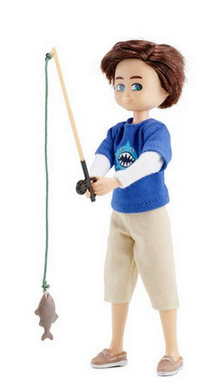 Lottie Dolls recently introduced Finn, their new boy doll character, which once again represents this kind of subtle ‘hey, he kinda looks like me’ realistic nudge some kids long for, while peeling off societal mores.
Lottie Dolls recently introduced Finn, their new boy doll character, which once again represents this kind of subtle ‘hey, he kinda looks like me’ realistic nudge some kids long for, while peeling off societal mores.
As the Representation Project’s film “The Mask You Live In” attests (premiering at Sundance in January 2015) boys could use some space to be free to be whoever they are without judgment too! Sometimes it pays to be a bit maverick, as Lottie Dolls has already established an equalizing force in play patterns across gender lines into role play.
What about the boys? Well…they’ve already got ‘em covered.
Since I no longer have children in the 9-year old age bracket, and I don’t accept freebies with our pass through nonprofit policy, I tried asking for feedback and personal experiences about Lottie dolls via Twitter. My favorite quote for candor came from a UK mom Susan K. Mann, who replied,
“I haven’t come across dolls like Lottie before. I was a huge fan of Sindy as a child, whereas I hated the way Barbie looked, dressed and her no brain like attitude…Sindy always looked like a real girl and did real things. I never found anything to replace her. Then I came across Lottie, I’d just had my baby girl and was pleased I’d have something that I felt proud about to pass onto her to play with. Something that didn’t have makeup, high heels, skinny waists and boobs.
Lottie is a child’s body as it should be, a child for a child. Having had two boys, I brought my boys up to feel that toys were toys. Not boys toys or girls toys…I took some flack from relatives; I bought them a buggy and dolls to put in it and why shouldn’t they push dolls in prams? My husband pushes them in a pram. My oldest son also loved dolls, he was desperate for a Rapunzel doll when Tangled came out and even at almost 8 wanted an Elsa doll when Frozen came out…”
Susan mentioned how her sons are huge football fans who also happen to like pink, and how her girl is barely two but loves cars as well as zooming Lottie around the room, and dressing/undressing her and brushing her hair, though she says she’s still young for imagination roles, adding,
“My boys have Finn and they have him interacting with Pirate Lottie and Spring Celebration Lottie. They sometimes play football with them setting up a team or use them to talk to each other. It’s fascinating to watch. They like to move them around as if they are walking.”
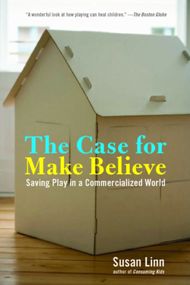 As I flinched at the accolades sounding like a product review, I searched the web and found multiple parents crowing with equal enthusiasm. It dawned on me that they’re really just voicing elements of the value of “unstructured pretend play or as author and Harvard psychologist Susan Linn might say, “The Case for Make Believe,” with kids co-playing freely, as it should be.
As I flinched at the accolades sounding like a product review, I searched the web and found multiple parents crowing with equal enthusiasm. It dawned on me that they’re really just voicing elements of the value of “unstructured pretend play or as author and Harvard psychologist Susan Linn might say, “The Case for Make Believe,” with kids co-playing freely, as it should be.
The expression of their child’s play may sound contrived at first, but I now see that it’s because we’ve come a long way…in the wrong direction.
I found a similar feedback loop with new parents being “amazed and inspired” by the hands-on kids crafts in Amazon’s Creative Galaxy show…This generation of parents were simply not used to being exposed to hands-on creation that some of us grew up with as a ‘given.’ Instead, the stilted, stagnant gender striations and color-coded formative play that wedges kids into narrowcast molds feels like a big exhale when those stifling parameters are removed and children are reintroduced to “let kids be kids, let toys be toys” elements of innovation. It’s not “rocket science” it’s just a smart, common sense, passionate market correction that’s long overdue…
As the big film studios finally start to have a Hollywood climate change and warm to “sheroes” that are strong, resourceful, multidimensional characters, (yay!) indie toy companies like Lottie Dolls will have already led the way and done their part by merely existing to cut through the clutter in a crowded marketplace of sameness.
Maya Angelou said, “Don’t bring negative to my door.”
Lottie Dolls seem to be the toy industry equivalent of that phrase…giving parents the pushback positioning we’ve long been seeking to change the channel of influence from negative messages that have come to our door, our homes, and seeped into kids psyches causing damage. Looking forward to healthier horizons ahead and a market correction that sticks.
Here’s more about their vision in a video of Lucie Follett, and a brief conversation with Managing Director Ian Harkin:
Amy Jussel, Shaping Youth: Can you tell me how the market demand has surged, and what needs to happen to make it do so even further?
 Ian Harkin, Arklu: The Lottie doll was actually conceived on feedback from 18 months of research with focus groups with parents, kids and child development experts.
Ian Harkin, Arklu: The Lottie doll was actually conceived on feedback from 18 months of research with focus groups with parents, kids and child development experts.
The feedback suggested there was a huge demand for a doll that addressed the compression of childhood, parental concerns such as body image, premature sexualization through inappropriate music videos and clothing (even on dolls).
After selling Lottie for over a year we had been contacted by parents asking for a doll for their sons, last month we launched Finn, a doll that gives boys an alternative to violent and aggressive computer games. Finn does all the things a normal kid does, sports, fishing, skateboarding etc. and our first shipment sold out in the USA and UK in the first week.
Social media, PR and validation from winning 19 International toy awards has helped us appoint 16 international distribution partners to cover distribution in 30 countries inside 2 years. In the USA Lottie is on sale in Toys R Us, Barnes and Noble, Hallmark and Amazon, in independent retail however we are working closely with over 1,000 stores in the US, in specific stores we are seeing Lottie outsell all other doll brands where retailers know about the research, the values and the positive feedback from returning customers. Word of mouth is really helping drive us forward, in the UK we have appointed 20 Brand Ambassadors and we are starting our search in the USA, they are bloggers who really believe in the brand, their opinions are honest and that positive feedback is driving us forward.
Amy Jussel, Shaping Youth: Could you say more about the backstory on the fashion designs, how they’re created and what is selected to go from the drawing board to the marketplace? Which ones sell well, etc.?
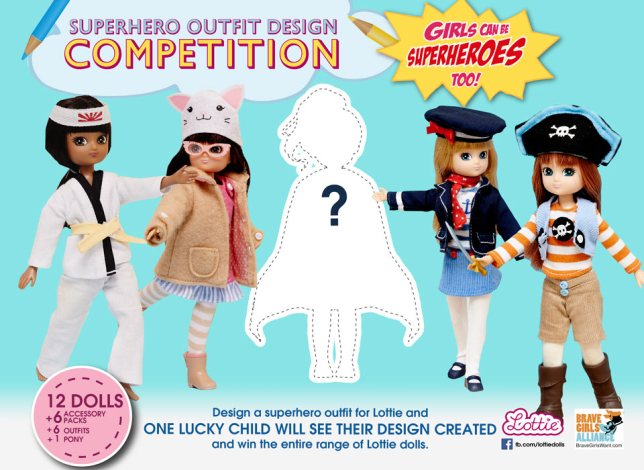 Ian Harkin, Arklu: My business partner Lucie is Creative director and she manages the design process. In our first year dolls we focused on outdoor adventures dressing Lottie in clothes kids actually wear (Lottie is based on a nine year old girl), in year two we were inspired by real world examples of strong female characters, Erin Kennedy from Montreal also known as RobotGrrl and Cathy Ceceri both female robotics experts.
Ian Harkin, Arklu: My business partner Lucie is Creative director and she manages the design process. In our first year dolls we focused on outdoor adventures dressing Lottie in clothes kids actually wear (Lottie is based on a nine year old girl), in year two we were inspired by real world examples of strong female characters, Erin Kennedy from Montreal also known as RobotGrrl and Cathy Ceceri both female robotics experts.
We developed Kawaii Karate after being inspired by Debbie Steven who teaches girls self-defense in India and we developed Butterfly Protector as the life cycle of a butterfly tied in with Common Core Standards in our age group, and Pirate Lottie was inspired by the real life Pirate Grace O’Malley from Mayo in Ireland.
This year we ran a worldwide competition for a superhero outfit design competition in association with Brave Girls Alliance, the winning design was by 6 year old Lily from Cleveland Ohio which we launched last month. A few weeks ago we launched School Days in association with The Girls Leadership institute in America, we included collector cards with 10 Leadership Tips for Girls. We have chosen to have a strong ethnic offering despite not being the best sellers, our best sellers however are Pandora’s Box in the USA, Pirate Queen in the UK, in both countries the Superhero outfit is the best seller.
Amy Jussel, Shaping Youth: What are your biggest marketplace challenges and how do you get the word out?
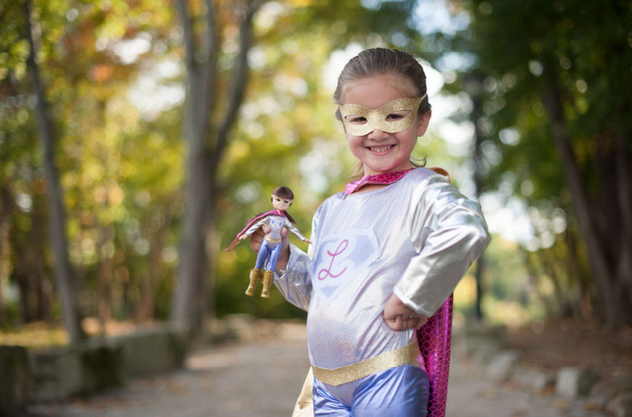 Ian Harkin, Arklu: Lottie is based on a 9 year old child, our message is about retaining childhood and letting kids be kids, all other dolls on the market are based on adults and adult agendas so no we don’t really see them as competition.
Ian Harkin, Arklu: Lottie is based on a 9 year old child, our message is about retaining childhood and letting kids be kids, all other dolls on the market are based on adults and adult agendas so no we don’t really see them as competition.
We are working on partnerships outside of toys… Awareness is the biggest challenge, we are a young, hungry self-funded business, we are reliant on PR, social media and word of mouth, and are extremely responsive to consumer feedback and ideas. Engaging with our consumer base we believe is giving us invaluable lessons and building loyalty.
In Spring 2015 we will be launching a series of Chapter books which tell of Lottie’s adventures…That’s the thing with Lottie, girls relate to her “she’s just like me.” We want Lottie to be a positive role model, she’s not perfect she makes mistakes but she learns from them, she’s real. The big players are using TV advertising to get in front of kids, we know kids love Lottie our awareness though is focused on parents and gift buyers it’s a slower market awareness plan but its building stronger relationships with kids and parents.
Background overview, provided by Arklu: Ian has been working in the Toy industry for almost 10 years. He and his business partner, Lucie Follett, formed Arklu in December 2010. Arklu created a name for themselves in the doll category with its first introduction, the Kate Middleton doll, which received international media praise. This led to the inspiration for creating Lottie, a wholesome doll alternative to the current doll industry. Through initial research, Arklu discovered an article by Dr. Margaret Ashwell, which documented the negative impact fashion dolls had on girls perception of their own body shape. This launched 18 months of detailed research in the creation of Lottie. Launched in August 2012, Lottie is described as a wholesome alternative doll based on a nine year old child, who does not wear make-up, jewelry or high heels. Lottie is now selling in 30 countries, won 19 awards and is seeking to further develop the brand through a series of books.
Visual Credits: Stargazing-Zastavki.com, Lottie Dolls and Lego Research Institute via their respective sites
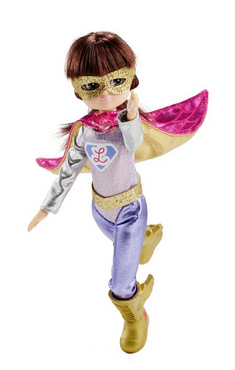








Speak Your Mind